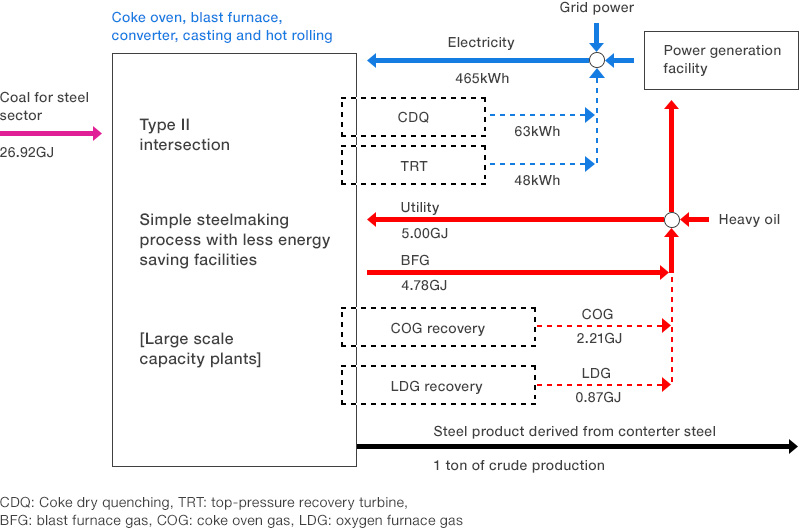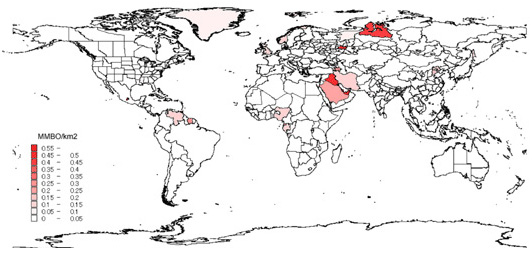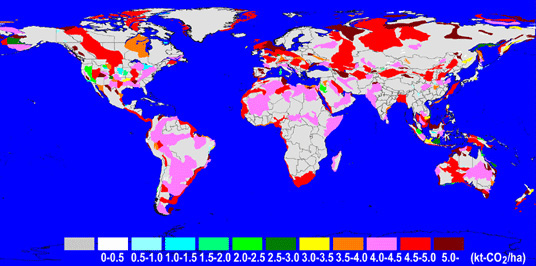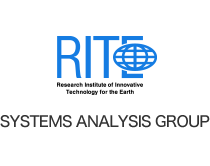Global Warming Research & Analyses
RITE Global model for Energy and Climate Change Assessment: DNE21+
Overview of DNE21+
August, 2008
RITE Global model for Energy and Climate Change Assessment: DNE21+
Overview of DNE21+
RITE built a model that can assess cost-efficient global warming countermeasures for the period of up to 2030 while dividing world into 77 regions, in order to analyze and assess global warming framework beyond second commitment period while reflecting regional difference well in itself.
-
1.Model type : linear programming model - minimizing net energy system cost
DNE21+ is a dynamic linear programming model that optimizes multiple time-points concurrently. It also features a capability of explicit assessment of global warming countermeasures by bottom-up modeling of energy supply (electricity generation, etc.) and CCS technologies. For an assessment of bottom-up reduction target, it has a capability of explicit assessment of energy-saving/global warming countermeasure technologies in energy-intensive sectors such as iron-and-steel or cement by bottom-up modeling of individual technologies, while top-down approach is adopted to assess energy demand side technologies. -
2.Evaluation time period: 2000-2050, variable
Being intended to analyze and assess mainly for the time beyond second commitment period, this model is structured to deal with a relatively short interval time of 5 years up to 2030. Reference year is 2000, and optimized representative years are 2005, 2010, 2015, 2020, 2025, 2030, 2040, 2050, 2075 and 2100. However, when optimization calculation, evaluation time periods differ dependent on the assessed reduction framework; for bottom-up emission targets, analysis and assessment is limited for the time period of up to 2030 due to a difficulty of projection of individual technologies in energy demand sectors; for long-term stabilization targets of CO2 concentration, analysis and assessment is possible for up to 2050 or 2010.
-
3.Worldwide assessment with 54 regions
Easy to divide regions such as COP Annex-I parties, EU or ASEAN, as the main objective of this model is to assess the impact of frameworks and targets of CO2 reduction on the reduction cost especially in Asian countries. Country-level regionalization is 54, and total regionalization is 77 as more detailed geographical segmentation is made to US, Canada, Russia, China, India and Australia. For example, 6 participating countries to Asia-Pacific Partnership for Clean Development and Climate (APP) have separated, and analysis, comparison and assessment of those countries can be achieved easily.

-
4.Modeling of energy conversion process
Modeling of energy conversion process is similar to that of DNE21. For a precise description of reginal difference, various types of facilities are modelled (e.g. low efficient but cheap, high efficient but expensive in coal power sector). This may be effective for analysis and assessment considering Energy Efficiency Standard or financial restriction in developing countries (possible to tie-up with CDM analysis). Meanwhile, top-down approach is basically adopted for energy demand technologies, and bottom-up approach is applied for modeling of individual technologies in energy-intensive sector like iron-steel, cement, paper & pulp, petrochemical to assess bottom-up reduction target. With those modeling method, specific technology countermeasures for energy conversion process or energy demand technology can be explicitly shown. As countermeasures in both energy supply side and energy demand side are assessed integrally by the model, totally consistent countermeasures can be obtained.

Modeling in iron-and-steel sector (for a part of mid-level energy saving/CO2 emission reduction technology)
-
5.Data preconditions
Most of the data used in the model have high consistency with GIS (Geographical Information System) data due to their detailed regionalization, and rest of them are also based on each country's data. Data such as fossil fuel resources, renewable energy resources, CCS potentials are consistent with GIS data, and data such as final energy demand, vintage (time and capacity of equipment constructed) of power generation facilities and other energy conversion facilities are consistent with each country's statistic data.

Assumption of oil resources(conventional) (source: US Geological Survey)

Assumption of maximum CO2 sequestration potential to aquifer (Assumed by RITE based on sedimentary basin data from USGS. In this model 10% of land, 20% of coastal area are assumed to be available)




